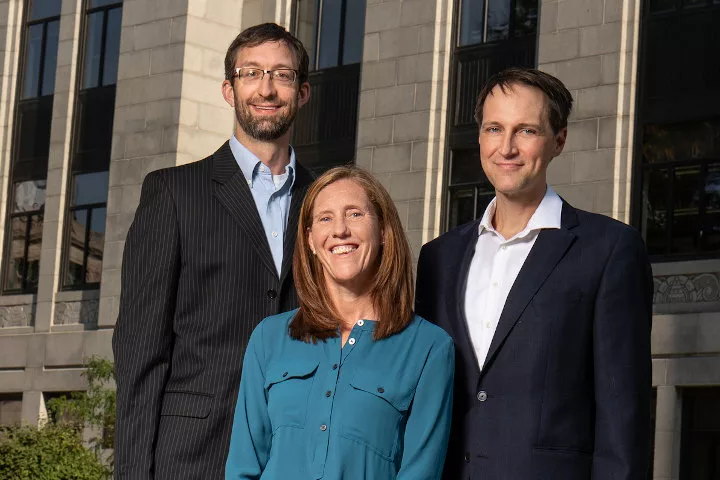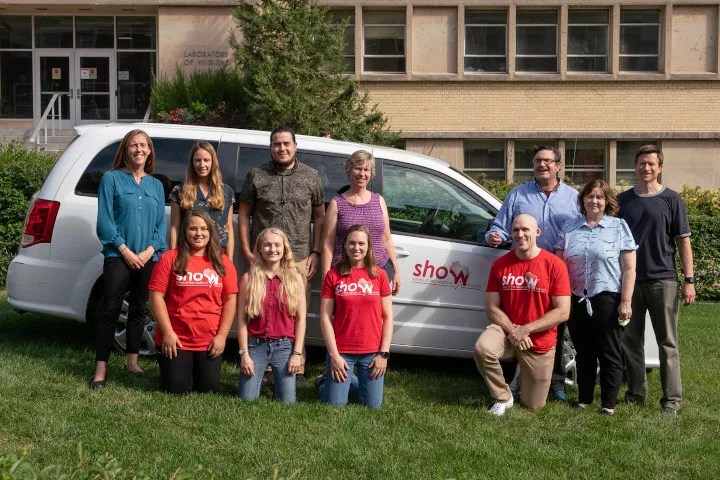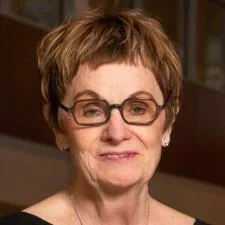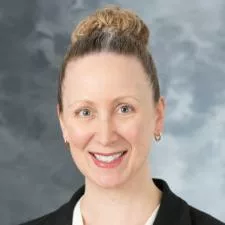Michelle Buelow Receives Max Fox Award
The annual award goes to a Wisconsin physician whose outstanding service as a preceptor has played an important role in the education of UW medical students.
When the first case of COVID-19 in Wisconsin was confirmed by the state’s Department of Health Services (DHS) on Feb. 5, 2020, the University of Wisconsin School of Medicine and Public Health’s Survey of the Health of Wisconsin (SHOW) — a statewide research infrastructure within the school — sought to leverage its extensive health data and bio-sample collection to assist the university and state in the face of the growing pandemic.
SHOW investigators, led by the program’s director, Kristen Malecki, PhD, MPH, an associate professor in the UW Department of Population Health Sciences, quickly mobilized their research team and study participants across Wisconsin to support the DHS’s need for critical, timely data on COVID-19’s spread.
Ryan Westergaard, MD, PhD, MPH, chief medical officer at the DHS and an associate professor in the UW Department of Medicine, approached Malecki to request SHOW’s help in assessing the extent of COVID-19 exposures in the population. Westergaard’s team wanted to track seroprevalence over time and viewed SHOW as an unbiased source of data collection because the organization has a broad and diverse research cohort.

At the time, testing capacity was limited, and because many people who have COVID-19 are asymptomatic, tracing the spread of the virus could not rely solely on counting cases based on test results. Better data was needed, notes Westergaard.
Thus, SHOW launched the longitudinal Past Antibody/COVID-19 Community Survey (PACCS). Program leaders sent teams to 24 community-based sites in 10 counties, where participants from previous SHOW study cohorts completed a brief questionnaire, and phlebotomists — armed with coolers and centrifuges — collected research subjects’ blood samples on site. The Wisconsin State Laboratory of Hygiene, which is part of the the School of Medicine and Public Health, tested the samples to measure antibody levels to determine whether a person had been infected by the virus that causes COVID-19.
The resulting data presented a clear and concerning picture of COVID-19’s progression. In June and July 2020, among just more than 1,000 samples from adults and children age 12 and above, 1.6 percent showed evidence of prior infection. In October and November 2020, overall statewide seroprevalence grew to 6.8 percent, and by March and April 2021, this had risen to 11.4 percent.
Especially concerning were findings from particular sub-groups. By October 2020, more than 25 percent of Latino participants had antibodies. Although no children had tested positive in July 2020, 19.3 percent of youth participants were positive by March 2021. And among those who self-identified as Black or African American, seroprevalence rose from 6.1 to 20 percent across the three time points.
Westergaard and his team were able to use the data at critical moments in the pandemic’s trajectory, says Malecki. According to the Morbidity and Mortality Weekly Report published by the Centers for Disease Control and Prevention in late January 2021, confirmed cases reported to the DHS between early September and mid-November 2020 were increasing at a rate of 24 percent per week — the highest in Wisconsin to that point. At that time, more than 90 percent of the population in Wisconsin had no antibodies to fight COVID-19 infection, and a vaccine was still weeks to months away.
“Having statewide data that can be regionalized and stratified by a host of demographic factors is significant. When we did our second wave of serological surveillance with past participants from the south side of Milwaukee, we saw almost a fourfold increase in antibody prevalence in those populations,” Malecki states.
This was a stark reminder of the disproportionate impact COVID-19 was having in communities that were already experiencing health inequities and inequitable access to resources.
“If you don’t have community-specific data and information, those patterns would be lost,” she observes, adding that by the end of 2020, COVID-19 was one of the three leading causes of death in Wisconsin. Parallel to the PACCS study, SHOW quickly adapted its follow-up study to its annual health survey of state residents.
“We realized we had an incredible opportunity to leverage connections we had already established with more than 5,000 Wisconsin residents,” says Malecki. “We asked ourselves, what if we engaged people to better understand how the COVID-19 pandemic was impacting their lives?”
In answer, SHOW launched the first iteration of its online Community Impact Study, a baseline snapshot of COVID-19’s early effects on Wisconsin residents. Amy Schultz, MS ’15, PhD ’19, SHOW’s associate director, and Doug Esselman, SHOW’s field-team supervisor, worked with SHOW scientists and other UW–Madison faculty members, including Paul Peppard, MS ’94, PhD, professor, Department of Population Health Sciences; Ajay Sethi, PhD, MHHS, associate professor, Department of Population Health Sciences; Corinne Engelman, MSPH, PhD, professor, Department of Population Health Sciences; and Lisa Cadmus-Bertram, PhD, associate professor, Department of Kinesiology, UW School of Education.
The team developed a plan to safely gather data from 5,800 past participants. They also gathered input from UW–Madison faculty members who were seeking information spanning health, social sciences, and child and family development.
Nearly 1,400 SHOW participants returned the surveys, which looked at nine areas of potential impact, ranging from perceptions of the risk of COVID-19 to issues of food security, economic stability and mental health.
More than 80 percent of respondents reported using some form of mitigation strategy, such as maintaining social distancing and canceling travel. Across social and economic groups, those with children at home reported considerably more stress compared to those without children. While 56 percent of respondents said they had not faced delays in receiving health care, about 35 percent said they couldn’t get dental care early in the pandemic, and 22 percent said the same about general medical care. Mental health emerged as another major area of concern.
“Early on, it became clear that families were struggling,” states Malecki. “People reported having a lot of uncertainty and fear about COVID-19 and where it was heading, and there was so much disruption to people’s lives.”
As of late 2021, data from the survey’s third wave have been collected, so more insights are on the horizon.
Through grant funding from the school’s Wisconsin Partnership Program, SHOW and many other organizations were able to adapt their work in response to the pandemic.
“It was remarkable to see SHOW quickly mobilize its staff and infrastructure to provide vital surveillance support at such a critical time in our state,” notes Richard Moss, PhD, then the school’s senior associate dean for basic research, biotechnology and graduate studies (now retired) and chair of the Wisconsin Partnership Program’s Partnership Education and Research Committee. “This valuable statewide data provides important insight into population health, and it has helped people in Wisconsin better understand the health risks and consequences of the pandemic.”
The Survey of the Health of Wisconsin (SHOW) is a novel statewide research infrastructure established at the University of Wisconsin School of Medicine and Public Health in 2008. It is funded through the school’s Wisconsin Partnership Program. To date, that program has committed to SHOW more than $22 million in awards, which have enhanced the school’s capacity to support the health research needs of investigators at the School of Medicine and Public Health and beyond.

Initially, SHOW’s primary focus was a statewide survey of representative Wisconsin households to generate state-specific data about residents’ health. The survey included questions on physical, mental and oral health; occupational, lifestyle and behavioral choices affecting health; and health literacy. The core set of health data maintained by SHOW is readily available to answer new research questions.
In addition, SHOW has expanded its work to support health equity research. Over the years, it has assembled a cohort of 5,846 adult and 980 minor participants from communities around Wisconsin. Its extensive health data and corresponding biological samples offer researchers unique opportunities to study how the social determinants of health intersect with the health status of particular populations in the state. SHOW offers:
The Wisconsin Partnership Program represents a far-reaching commitment by the University of Wisconsin School of Medicine and Public Health to greatly improve the health and well-being of people in Wisconsin now and for years to come. The program reaches beyond the UW–Madison campus to improve the health of Wisconsinites through innovative research and education programs and community partnerships.

After 20 years serving as the founding director of the Wisconsin Partnership Program, Eileen Smith retired at the end of 2021.
“Eileen has provided visionary leadership and incredible dedication to this groundbreaking program since its inception. During her tenure, the Wisconsin Partnership Program has awarded more than $270 million in grant programs that advance medical and public health research; support innovations in medical education; and promote health and health equity,” notes Robert N. Golden, MD, dean of the SMPH. “The program’s impact has been tremendous, resulting in nearly 550 research, education and community partnerships reaching people and communities in all 72 counties of the state — a true embodiment of the Wisconsin Idea.”

As of December 1, 2021, Amy J.H. Kind, MD ’01 (PG ’07), PhD ’11, has become the executive director of the Wisconsin Partnership Program. A professor in the UW Department of Medicine, Kind has served as chair of the program’s Oversight and Advisory Committee. She also is the director of the UW Center for Health Disparities Research, and in December 2021, she was named the School of Medicine and Public Health’s inaugural associate dean for social health sciences and programs.
“As an international leader in the field of neighborhood-level health disparities, Dr. Kind’s expertise, experience and commitment to health equity will serve to guide the Wisconsin Partnership Program into the future,” says Golden.